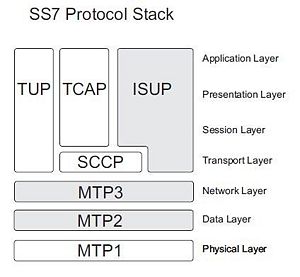Toolpack v2.3:SS7
SS7 is a signaling protocol that is used to set up and tear down phone calls. It also provides support for such functionality as local number portability, Short Messaging Service (SMS), prepaid billing and number translation.
The configuration of SS7 requires that the physical layer, through to the transport layer, and up to the application layer be configured. SS7 configuration involves configuring values for MTP2 Layer, MTP3 Layer, and ISUP.
A conceptual illustration of the SS7 protocol stack is shown on the right. In the SS7 architecture, every layer has very specific task and responsibilities to provide to upper layers. Looking at the figure on the right, we see that an SS7 stack covers all levels of the OSI model from physical to application layer. Within this model, it is possible to replace one of more layers by another protocol as long as it provides the same functionalities. In a base call control application over a TDM network, the SS7 stack required would include layers MTP1 Layer, MTP2, MTP3 and ISUP or TUP.
It is worth pointing out that, by being layered in different functional groups, SS7 was built so that different nodes in the network don’t need to implement every portion of the protocol stack if they don’t require to.
TelcoBridges and SS7
TelcoBridges provides SS7 support with all of its media gateway, VAS development platform and monitoring devices. SS7 functionality is licensed separately and can be provided at initial purchase or added later on via a software license upgrade.
SS7 signaling is configured once for the entire Tmedia or Tdev system. Any one Tdev unit is capable of running the entire SS7 signaling stack for all the Tdev units in a system.
Systems developed using TelcoBridges hardware can support up to a maximum of 64 point codes. It is worth noting that a single pointcode can be used for 2 or more devices configured as a single system.
High availability (HA) has been designed into the architecture of the Tmedia product such that the failure of an SS7 stack on one Tmedia unit will be taken over by the SS7 stack of another Tmedia unit.
Click for further information on:
- Supported MTP2 standards and variants
- Supported MTP3 standards and variants
- Supported ISUP standards and variants
